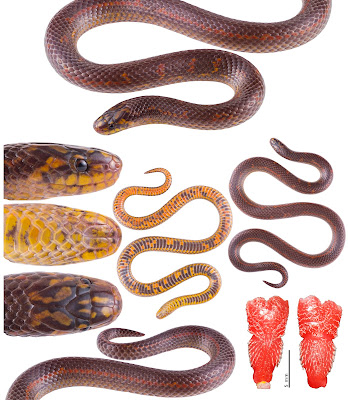Abstract
We review the taxonomy of Atractus species distributed continuously along northeastern portions of the Andes of Colombia (= Eastern Cordillera), Sierra of Perijá on the Colombia–Venezuela border, and Cordillera of Mérida in northwestern Venezuela. We assess the taxonomic status of 29 species names on the basis of congruence between quantitative and qualitative phenotypic characters (pholidosis, morphometrics, color patterns, scales micro-or-namentations, male genitalia, and osteological features) along their entire distribution. Our results support the recognition of 23 species, 6 of which are new to science (5 described herein), through unique morphological diagnostic characters or unique combinations. We propose the synonymy of 14 old and even recently presented names based on the widespread overlap of all morphological character systems analyzed. Taxonomic decisions were made on the light of examination of available type series, geographically representative samples, anatomical preparations or observations, and careful literature review for all taxa recorded in the study area. We provide a dichotomous key for all recognized species along northeastern Andes of Colombia to northwestern Andes of Venezuela. We compare the geographic variation, morphological cohesion, and distribution limits of highland Atractus and contrast them with lowland species. Finally, we discuss the ultimate implication of taxonomic studies delimited by political boundaries or based on geographically restricted samples, especially when such approaches rely extensively on online datasets without critical examination of specimens.
KEYWORDS: Hemipenian and skull morphology, Highland endemism, Linnean shortfall, microdermatoglyphics, morphometry, new species, new synonymies, polychromatism, species delimitation
Atractus dativus,
Atractus muisca,
Atractus pearti,
Atractus tritono,
Atractus uroborus
Paulo Passos, Elson Meneses-Pelayo, Luciana O. Ramos, Angele R. Martins, Alessandra Machado, Ricardo T. Lopes, César Barrio-Amorós and John D. Lynch. 2024. Taxonomy without Borders: Revision of the Genus Atractus (Serpentes: Dipsadidae) from the Andes between Colombia and Venezuela. South American Journal of Herpetology. 32 (sp1); 1-123. DOI: doi.org/10.2994/SAJH-D-23-00022.1
facebook.com/CesarBarrioAmoros/posts/1213381326887994
New species of the Atractus genus for science
The five new species described in this research work correspond to snake populations distributed in the Eastern Cordillera of Colombia, covering the departments of Boyacá, Santander, Norte de Santander, Cesar and La Guajira.
The first species, Atractus dativus, is known only from one locality in Boyacá, located between the municipalities of Soatá and Susacón. Its name, dativus, is a Latin adjective that alludes to the act of providing or offering something to someone. This term refers to the popular Colombian expression “God will provide”.
The second species, Atractus muisca, is found mainly in the department of Santander, in municipalities such as Floridablanca, Málaga, Charalá and Encino, on the border with Boyacá. Its name, Muisca, pays homage to the pre-Columbian civilization that inhabited the highlands of the Eastern Cordillera of Colombia. The Muiscas were a remarkable example of an egalitarian and sustainable society. Their caciques, wise administrators, implemented a system of social redistribution that complemented economic exchange. Through tribute, they retained productive surpluses and redistributed a part among the population through a common consumption fund.
The third species, Atractus pearti, inhabits the middle and highlands of the Serranía del Perijá, between the departments of Cesar and La Guajira. Its name pays homage to Neil Peart (1952-2020), iconic drummer and lyricist of the progressive rock band Rush.
The fourth species, Atractus tritono, is a species found in the municipalities of Chitagá, Pamplona and Toledo, Norte de Santander, at altitudes between 1700 and 2500 meters above sea level. The name of this species “tritone” refers to an interval between peaks of two musical notes that has exactly three whole tones.
The fifth and last species, Atractus uroborus, inhabits only the highlands of the Serranía de los Yariguíes between the municipalities of Zapatoca and El Carmen de Chucurí. The name of this species corresponds to an ancient symbol that shows a snake biting its tail, a symbol used in Greek mythology and Egyptian culture. The uroborus is often interpreted as eternal renewal of the cycle of life, death and rebirth.
This work highlights the crucial role of scientific research in protecting and understanding biodiversity in one of the most diverse areas of the planet.
Se revisó la taxonomía de las especies de Atractus distribuidas continuamente a lo largo de los Andes nororientales de Colombia (= Cordillera Oriental), Sierra de Perijá en el límite Colombia-Venezuela y Cordillera de Mérida en el noroeste de Venezuela. Se evaluó la posición taxonómica de 29 nombres de especies a través de la congruencia entre caracteres fenotípicos cuantitativos y cualitativos (folidosis, morfometría, patrones de color, micro-ornamentaciones de escamas, genitales masculinos y características osteológicas), a lo largo de toda su distribución. Nuestros resultados apoyan el reconocimiento de 23 especies, 6 de estas nuevas para la ciencia (5 descritas aquí), por medio de caracteres diagnósticos únicos o una combinación exclusiva de estas características. La sinonimia de 14 nombres antiguos y algunos presentados recientemente ha sido basada en la amplia superposición de todos los sistemas de caracteres morfológicos analizados. Se tomaron decisiones taxonómicas a la luz del examen de las series de tipos disponibles, muestras geográficamente representativas, preparaciones o observaciones anatómicas y revisión cuidadosa de la literatura para todos los taxones registrados en el área de estudio. Se presenta una clave dicotómica para todas las especies reconocidas a lo largo de los Andes nororientales de Colombia hasta los Andes noroccidentales de Venezuela. Se comparó la variación geográfica, la cohesión morfológica y los límites de distribución para los Atractus de las tierras altas en contraste con las especies de las tierras bajas. Por último, se discute la implicación de estudios de orientación taxonómica delimitados por fronteras políticas o aquellos basados en muestras geográficamente restringidas, especialmente cuando este enfoque se beneficia ampliamente solo de los conjuntos de datos en línea, sin examen crítico de especímenes.

